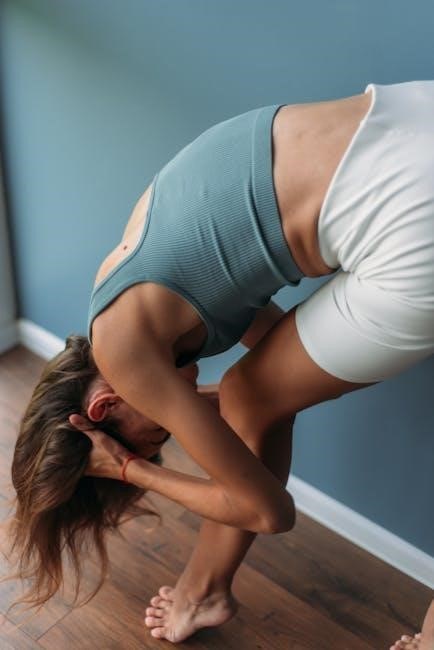
vinyasa yoga sequence pdf
Vinyasa Yoga is a flowing practice linking movement with breath‚ offering a meditative and physically challenging experience. It emphasizes sequencing and breath synchronization‚ making it accessible to all levels.
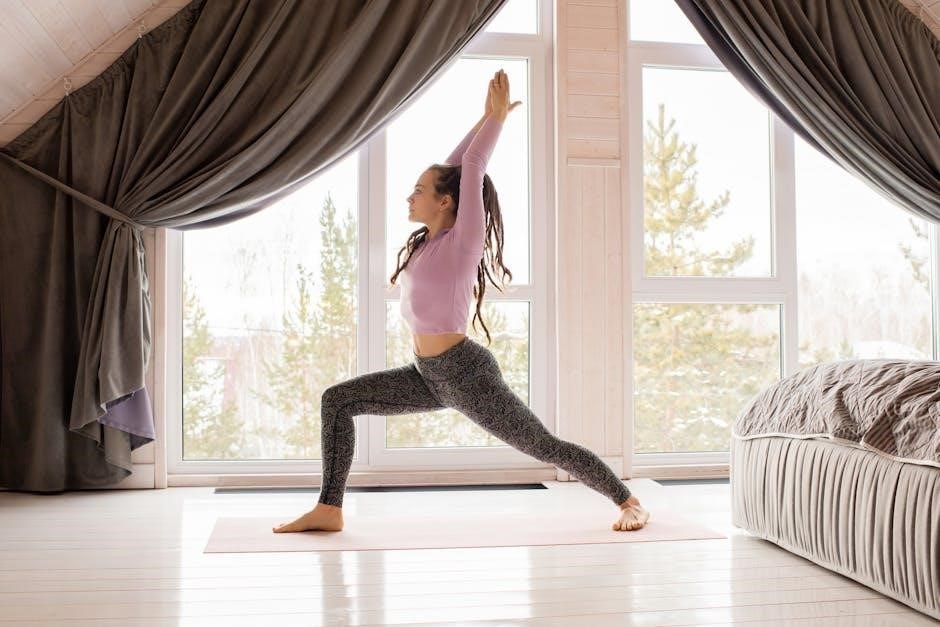
1.1 What is Vinyasa Yoga?
Vinyasa Yoga is a dynamic and flowing style of yoga that links movement with breath. It involves synchronizing breath with a series of postures‚ creating a meditative and physically challenging practice. Common sequences include Sun Salutations‚ which help build internal heat and strength. This flowing practice is designed to balance the body’s energy and prepare it for deeper postures and relaxation.
1;2 Benefits of Vinyasa Yoga
Vinyasa Yoga offers numerous benefits‚ including improved flexibility‚ strength‚ and cardiovascular health. The flowing sequences enhance circulation and detoxification‚ while the synchronized breathing calms the mind and reduces stress. This practice also boosts balance‚ focus‚ and overall physical endurance. Regular practice can lead to a stronger‚ more centered body and a clearer‚ more peaceful mind‚ making it an excellent choice for both physical and mental well-being.
1.3 Importance of Sequencing in Vinyasa Yoga
Proper sequencing in Vinyasa Yoga ensures a safe‚ effective‚ and meditative practice. It gradually prepares the body for more challenging poses‚ enhancing flexibility and strength. Logical flow links breath with movement‚ maintaining rhythm and focus. Sequencing also prevents injuries by warming up appropriately and cooling down effectively. A well-structured sequence creates a balanced practice‚ addressing physical‚ mental‚ and emotional well-being while fostering mindfulness and connection to the present moment. This intentional ordering is key to maximizing the benefits of Vinyasa Yoga.
Key Components of a Vinyasa Yoga Sequence
A Vinyasa Yoga sequence includes Sun Salutations‚ standing poses‚ and breath-synchronized movements‚ creating a flowing practice that builds strength‚ flexibility‚ and mindfulness‚ enhancing the connection between body‚ breath‚ and mind.
2.1 Sun Salutations (Surya Namaskar)
Sun Salutations are foundational in Vinyasa Yoga‚ linking movement with breath. This dynamic sequence warms up the body‚ preparing it for deeper postures. It includes poses like Mountain‚ Forward Fold‚ Plank‚ Upward-Facing Dog‚ and Downward-Facing Dog‚ synchronized with inhales and exhales. Regular practice enhances flexibility‚ strength‚ and cardiovascular health‚ while setting a meditative flow for the entire practice. Sun Salutations are often repeated to build internal heat and energy.
2.2 Standing Poses and Their Progressions
Standing poses are essential in Vinyasa Yoga‚ building strength‚ balance‚ and alignment. They often follow Sun Salutations‚ progressing from open-hip poses like Warrior II and Triangle to more challenging closed-hip postures like Warrior I and Revolved Triangle. These sequences enhance stability‚ flexibility‚ and internal heat‚ preparing the body for deeper postures. Proper progression ensures safety and effectiveness‚ allowing students to flow smoothly while maintaining breath awareness and engagement. Standing poses form the foundation of a balanced Vinyasa practice.
2.3 Breath-Synchronized Movements
Breath-synchronized movements are the core of Vinyasa Yoga‚ linking each pose to an inhalation or exhalation. This synchronization enhances flow‚ concentration‚ and inner balance. By aligning movement with breath‚ practitioners experience a meditative state‚ fostering mindfulness. Proper breathing techniques like Ujjayi (Ocean Breath) maintain rhythm and focus‚ ensuring a harmonious connection between body and breath throughout the sequence. This synchronization is key to the transformative power of Vinyasa Yoga‚ promoting physical and mental unity.
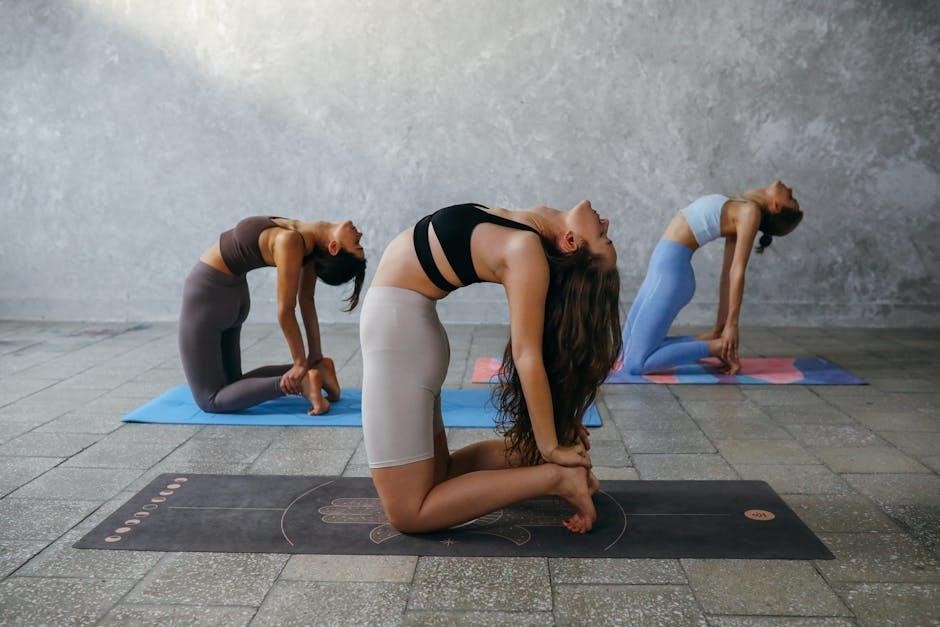
Structuring a Vinyasa Yoga Sequence
A well-structured Vinyasa sequence begins with foundational postures‚ progresses through a dynamic warm-up‚ builds intensity‚ and concludes with cooling poses and Savasana for a balanced practice;
3.1 The Arc of a Vinyasa Flow
A Vinyasa flow follows a dynamic arc‚ starting with grounding poses to prepare the body‚ transitioning into a warm-up to awaken the breath and movement‚ and building heat with dynamic sequences. The sequence then progresses to a peak pose or challenging postures‚ followed by cooling stretches to release tension and calm the nervous system. This intentional structure ensures a safe‚ balanced‚ and transformative practice‚ honoring the connection between breath‚ movement‚ and energy flow.
3.2 Warm-Up and Grounding Techniques
The warm-up phase in a Vinyasa flow is crucial for preparing the body and mind. It begins with grounding techniques‚ such as standing or seated postures‚ to establish balance and connection. Gentle movements like neck rolls‚ shoulder shrugs‚ and cat-cow sequences awaken the spine and improve flexibility. Breath awareness is introduced to synchronize movement with inhalation and exhalation‚ creating a meditative rhythm. This phase ensures a smooth transition into more dynamic flows‚ preventing injuries and enhancing overall practice effectiveness. Proper warm-up sets the foundation for a safe and engaging sequence.
3.3 Peak Pose and Its Significance
The peak pose is the climax of a Vinyasa sequence‚ providing focus and direction for the practice. It allows students to work toward a specific goal‚ enhancing learning and engagement. The peak pose is typically chosen based on class level and student ability‚ ensuring safety and accessibility. Proper preparation and sequencing lead up to this pose‚ with supporting postures that build strength and flexibility. The peak pose also includes the final relaxation‚ such as Savasana‚ where the body integrates the benefits of the practice‚ making it a holistic experience.
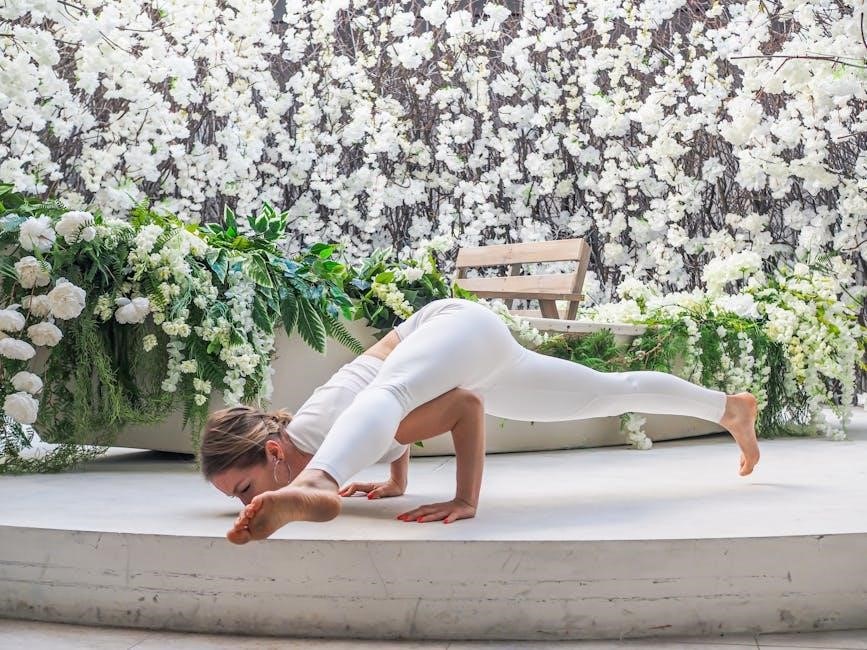
Modifications and Variations
Modifications and variations in Vinyasa Yoga allow for inclusivity‚ catering to all levels. Adjustments ensure safe practice‚ while variations challenge experienced practitioners‚ keeping sequences dynamic and engaging.
4.1 Adjustments for Beginners
For beginners‚ Vinyasa Yoga sequences often include modifications to ensure safety and accessibility. Poses like downward-facing dog and warrior can be adjusted using props or simplified movements. Instructors may offer alternatives to prevent injury and build confidence. Slowing down transitions and emphasizing proper alignment helps newcomers master fundamental poses. These adjustments create a nurturing environment‚ allowing beginners to gradually build strength‚ flexibility‚ and coordination as they explore the practice.
4.2 Advanced Variations for Experienced Practitioners
Advanced Vinyasa Yoga sequences offer complex transitions and challenging poses‚ such as Scorpion and King Pigeon‚ designed to deepen strength and flexibility. Experienced practitioners can explore dynamic movements like binds and inversions‚ adding depth to their practice. These variations often incorporate longer holds of peak poses‚ enhancing endurance and mental focus. Sequences may also include intricate flows‚ encouraging practitioners to push their limits while maintaining breath awareness and alignment.
4.3 Incorporating Props for Safe Practice
Using props like blocks‚ straps‚ and blankets in Vinyasa Yoga helps maintain proper alignment and prevents injuries. They support students with physical limitations or injuries‚ allowing them to modify poses safely. Blocks can lift the ground to meet the hands in forward bends‚ while straps help deepen stretches without strain. Blankets provide cushioning for joints‚ ensuring comfort during seated or balancing poses. Props empower students to practice confidently‚ making Vinyasa Yoga accessible and inclusive for all levels of ability.
Breathing Techniques in Vinyasa Yoga
Vinyasa Yoga emphasizes synchronized breathing‚ linking each movement with inhales and exhales. Techniques like Ujjayi (Ocean Breath) promote focus and rhythm‚ enhancing the flow and meditative experience.
5.1 Ujjayi Breath (Ocean Breath)
Ujjayi‚ or Ocean Breath‚ is a foundational technique in Vinyasa Yoga‚ characterized by a soft hissing sound produced by partially closing the glottis. This breath is practiced during asanas and transitions‚ helping to synchronize movement with respiration. It promotes relaxation‚ focus‚ and heat generation in the body‚ while maintaining a steady rhythm throughout the practice‚ enhancing both physical and mental awareness.
5.2 Linking Breath with Movement
Linking breath with movement is the essence of Vinyasa Yoga‚ creating a flowing sequence that harmonizes physical postures with respiratory rhythms. This synchronization enhances focus‚ balance‚ and awareness‚ transforming the practice into a meditative flow. By uniting inhalations and exhalations with movements‚ students experience a deeper connection between body and mind‚ fostering grace and fluidity in transitions while maintaining alignment and inner calm throughout the practice.
5.3 Pranayama for Deepening the Practice
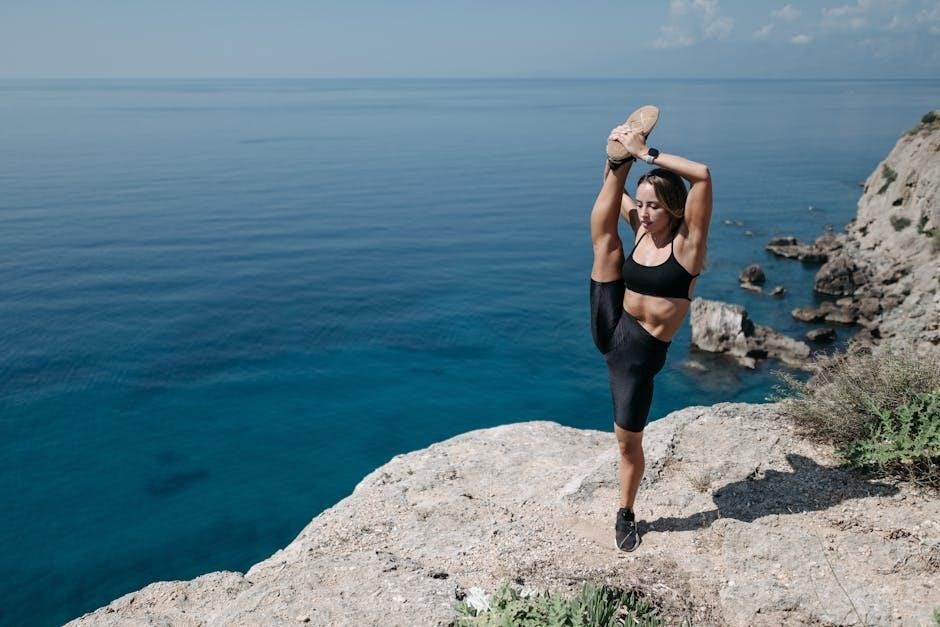
Pranayama‚ the art of breath control‚ enriches a Vinyasa Yoga practice by deepening awareness and fostering inner calm. Techniques like Ujjayi and Kapalabhati regulate breath‚ preparing the mind for meditation. Pranayama enhances oxygen flow‚ reduces stress‚ and centers the practitioner‚ creating a bridge between physical postures and mental stillness. Incorporating these breath practices in sequences amplifies the meditative quality of Vinyasa Yoga‚ transforming it into a holistic experience that unites body‚ breath‚ and mind for profound relaxation and self-discovery.
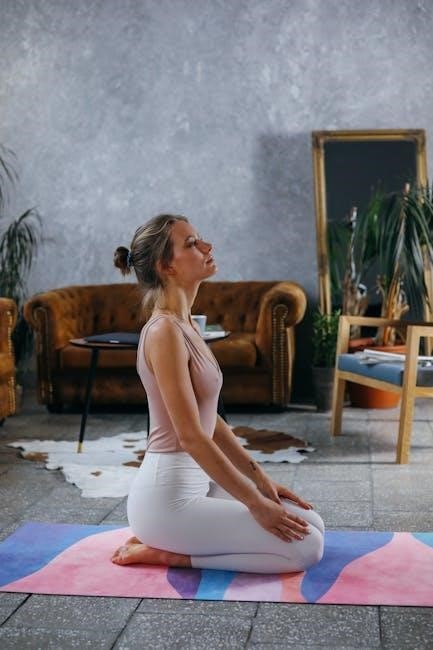
Sample Vinyasa Yoga Sequences
Discover diverse Vinyasa Yoga sequences designed for all levels‚ from beginner-friendly flows to advanced practices. These structured sequences guide practitioners through warm-ups‚ peak poses‚ and relaxation‚ enhancing strength‚ balance‚ and mindfulness while promoting deep relaxation and inner connection.
6.1 Beginner-Friendly Sequence
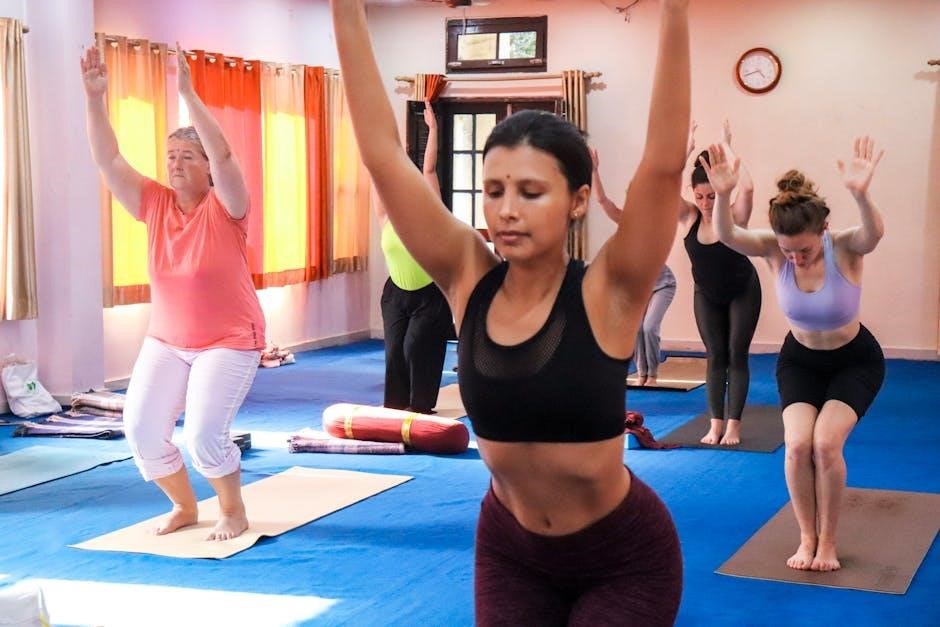
A beginner-friendly Vinyasa sequence starts with gentle warm-ups like cat-cow and neck rolls‚ followed by foundational poses such as Downward Dog‚ Cobra‚ and Child’s Pose. These flows are slow-paced‚ emphasizing proper alignment and breath awareness. Modifications and props are encouraged to ensure safety and comfort. The sequence gradually builds strength and flexibility‚ ending with a calming Savasana to promote relaxation and mindfulness. This approach helps new practitioners establish a strong foundation for their yoga journey.
6.2 Intermediate Flow for Strength and Balance
This intermediate sequence focuses on building strength and balance through dynamic flows and challenging postures. It begins with foundational poses like Warrior II and Revolved Triangle‚ progressing to balancing poses such as Crow Pose and Tree Pose. Core-strengthening movements and transitions like high-to-low lunges are incorporated to enhance stability. The sequence concludes with seated forward bends and Savasana‚ ensuring a well-rounded practice that balances strength‚ flexibility‚ and relaxation. Props are encouraged to maintain safe alignment and accessibility.
6.3 Advanced Sequence for Experienced Yogis
Designed for experienced practitioners‚ this sequence challenges with complex transitions and advanced postures. It includes poses like Scorpion and King Pigeon‚ along with dynamic flows that test strength and flexibility. The sequence builds on foundational strength‚ incorporating arm balances and deep twists. Modifications are provided to ensure safety‚ while the flow maintains a meditative rhythm. The practice culminates in Savasana‚ allowing the body to integrate the benefits of the intense workout‚ fostering balance and deep relaxation. Breathing techniques are emphasized throughout to enhance focus and endurance.
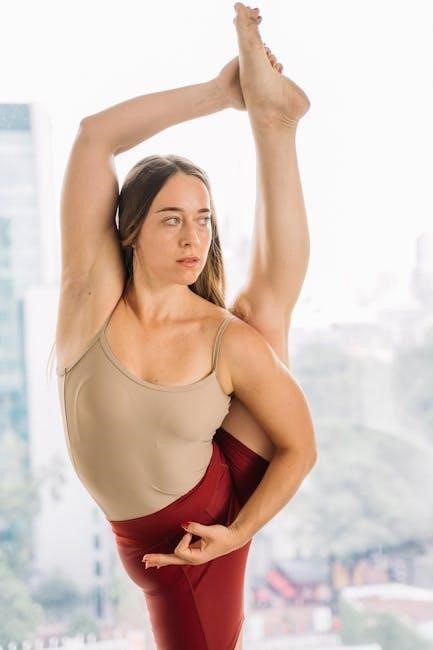
Resources for Creating Your Own Sequence
Explore free Vinyasa Yoga Sequence PDFs offering detailed instructions and inspiration. Utilize recommended yoga books for alignment insights and online tools for structuring unique flows tailored to all levels.
7.1 Free Vinyasa Yoga Sequence PDFs
Free Vinyasa Yoga Sequence PDFs are excellent resources for teachers and students. These guides offer detailed instructions‚ modifications‚ and breathwork integration for safe practices. Many include beginner-friendly sequences‚ intermediate flows‚ and advanced postures‚ ensuring versatility for all levels. They often feature step-by-step instructions‚ photos‚ and tips for linking movement with breath. Websites like YogaRenew provide free downloadable PDFs‚ such as their 60-minute Vinyasa Yoga Sequence‚ perfect for inspiration and structured practice. These resources are ideal for creating balanced and effective flows at home or in class.
7.2 Recommended Yoga Sequence Books
Recommended yoga sequence books offer insights into creating structured and inspired flows. Titles like The Art of Vinyasa and Yoga Sequencing provide detailed alignment tips and sequence ideas. These books are ideal for teachers seeking to deepen their understanding of pose progression and breathwork. They often include tips for teaching to a peak pose and crafting thematic classes. Such resources are invaluable for educators and practitioners alike‚ offering both practical guidance and creative inspiration for designing meaningful vinyasa flows.
7.3 Online Tools and Guides
Online tools and guides are invaluable for creating vinyasa yoga sequences. Websites offer downloadable PDFs‚ video tutorials‚ and interactive planners. Platforms like YogaRenew provide comprehensive guides‚ such as their 60-Minute Vinyasa Yoga Sequence PDF‚ which includes templates and tips for structuring classes. These resources help teachers and students alike design safe‚ effective‚ and engaging flows‚ ensuring a balanced practice that honors tradition while encouraging creativity and growth in yoga sequencing skills.
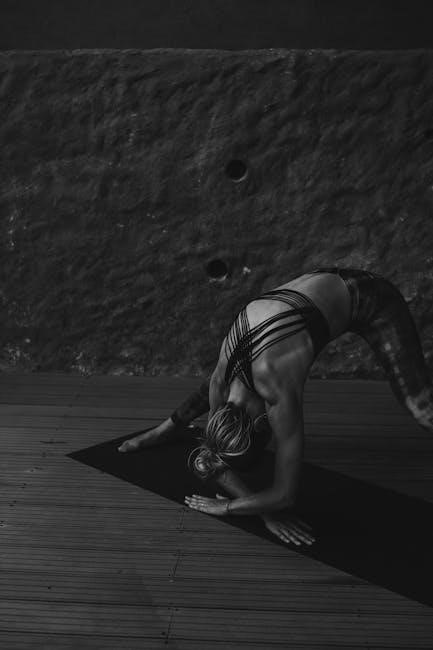
Tips for Teachers and Students
Start with foundational poses‚ build sequences gradually‚ and emphasize breath awareness. Use peak poses for focus and include relaxation techniques like Savasana for a balanced practice.
8.1 How to Sequence Safely and Effectively
Start with foundational poses like sun salutations to warm up. Build sequences logically‚ progressing from simple to complex poses. Include modifications and props to ensure safety. Focus on linking breath with movement for a meditative flow. Avoid rushing into challenging poses; warm up thoroughly first. Use peak poses as a focal point and wind down with relaxing postures. Ensure a balanced practice by incorporating standing‚ seated‚ and restorative poses‚ ending with Savasana for deep relaxation.
8.2 Teaching to a Peak Pose
Choose a peak pose based on class level and student ability. Build the sequence to prepare for this pose‚ incorporating warm-ups and foundational postures. Use modifications to ensure accessibility. Teach progressively‚ linking breath with movement to maintain flow. Highlight alignment cues specific to the peak pose. Allow time for students to explore and deepen their practice. This structured approach helps students feel prepared and confident‚ enhancing their learning experience and connection with the practice.
8.3 Using Music and Themes in Your Sequence
Music and themes enhance the Vinyasa Yoga experience‚ creating a cohesive and engaging practice. Choose playlists that align with your sequence’s intensity and flow‚ setting the tone for each phase. Themes like balance‚ strength‚ or renewal help tie poses together‚ offering students a narrative to follow. Use music to maintain rhythm and inspire movement‚ while themes provide emotional and mental focus‚ fostering a deeper connection to the practice and its benefits.
The Role of Savasana
Savasana‚ or Corpse Pose‚ is the final relaxation‚ allowing the body to absorb practice benefits‚ calm the mind‚ and rejuvenate the spirit‚ essential for completing the sequence.
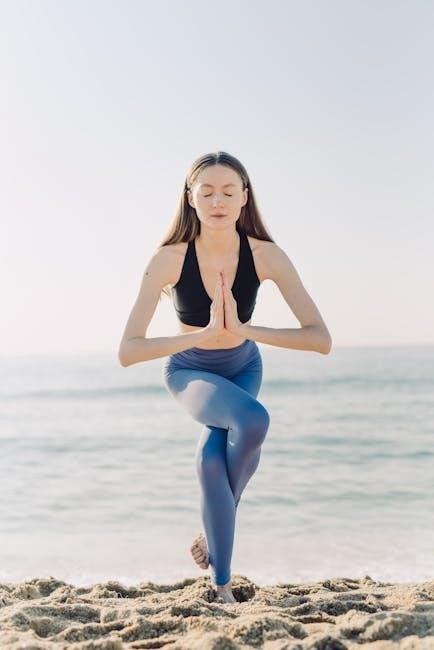
9.1 Wind Down and Relaxation Techniques
Wind down techniques in Vinyasa Yoga involve gentle stretches‚ deep breathing‚ and progressive muscle relaxation. These practices transition the body from dynamic flow to stillness‚ preparing for Savasana. Instructors often guide students through calming postures like seated forward bends or supine spinal twists to release tension. Breathing exercises‚ such as Ujjayi or alternate nostril breathing‚ further promote relaxation‚ ensuring a smooth transition into the final pose. This phase is crucial for mental and physical rejuvenation.
9.2 Integrating Meditation and Breathing Exercises
Integrating meditation and breathing exercises into a Vinyasa Yoga sequence enhances the mind-body connection. Techniques like Ujjayi breath synchronize movement with inhalation and exhalation‚ fostering focus and flow. Meditation can be woven into transitions‚ encouraging mindfulness and presence. These practices deepen the yoga experience‚ promoting mental clarity and emotional balance. By incorporating Pranayama or guided meditations‚ students can transition smoothly into Savasana‚ amplifying the practice’s calming effects and preparing the mind for deeper relaxation and self-reflection.
9.3 The Importance of Final Relaxation
Final relaxation‚ often in the form of Savasana‚ is crucial for completing a Vinyasa Yoga practice. It allows the body to absorb the benefits of the sequence‚ calming the nervous system and promoting deep relaxation. This phase helps reduce stress‚ rejuvenate energy‚ and enhance overall well-being. By integrating meditation and breathwork‚ students can fully surrender‚ allowing the mind and body to connect on a deeper level‚ making it an essential conclusion to any Vinyasa flow sequence.
Cultural and Historical Context
Vinyasa Yoga originates from ancient yoga traditions‚ evolving into a dynamic flow practice. It honors the lineage of Krishnamacharya and Pattabhi Jois‚ blending breath and movement while respecting its cultural roots.
10.1 Origins of Vinyasa Yoga
Vinyasa Yoga traces its roots to ancient Indian yoga traditions‚ evolving from the teachings of Krishnamacharya and Pattabhi Jois. The term “Vinyasa” refers to the linking of breath with movement‚ creating a flowing sequence. This practice is deeply connected to the Ashtanga Yoga system‚ which emphasizes synchronized breathing and progressive sequences. Over time‚ Vinyasa Yoga has modernized while preserving its traditional essence‚ making it a popular global practice today.
10.2 Evolution of Vinyasa Flow Practices
Vinyasa Flow has evolved from its roots in Ashtanga Yoga‚ embracing diverse styles and creative sequencing. Modern teachers have adapted traditional flows to suit various levels and themes‚ incorporating music‚ meditation‚ and dynamic transitions. This evolution reflects a shift toward accessibility and personalization‚ allowing practitioners to connect with the practice on a deeper level while maintaining its core philosophy of linking breath with movement.
10.3 Respect for Tradition in Modern Sequencing
Modern Vinyasa Yoga honors its roots by maintaining foundational principles like breath-synchronized movements and Sun Salutations. Teachers blend traditional poses with contemporary sequencing‚ ensuring practices remain authentic yet innovative. This balance preserves the lineage while catering to diverse student needs‚ fostering a deep respect for yoga’s heritage in every sequence created.
Leave a Reply
You must be logged in to post a comment.